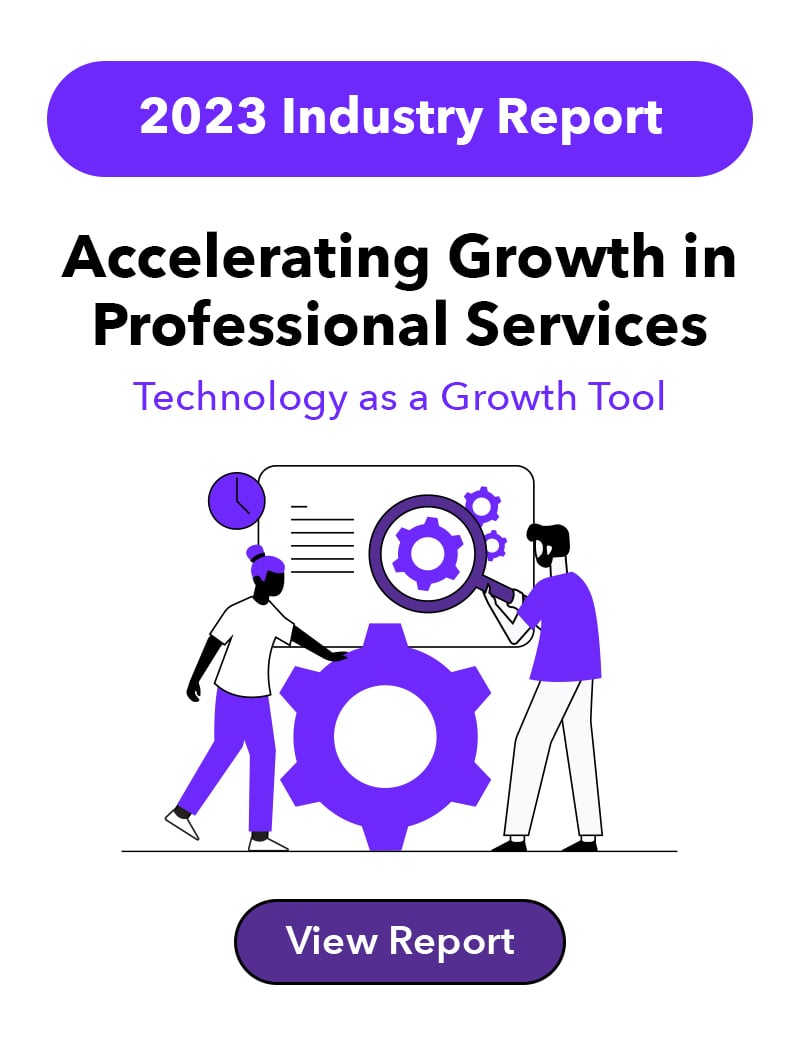What will your firm’s tech strategy look like in five years? What about next year? If your professional services firm is operating with the same outdated processes, you are missing a huge opportunity for growth.
Embracing digital transformation strategies now can help secure your firm’s stability tomorrow.
What is Digital Transformation?
Digital transformation is the process of integrating technology into all areas of a business, changing how it operates.
While it's readily adopted by industries like healthcare, manufacturing, energy, and utilities, the professional services industry has been slow to shift to this mindset. It could be because many firms think they’re already doing a good enough job with their tech strategies, but that might not be the case.
A Pitchly report found that when C-suite respondents were asked about their digital transformation strategy, 100% reported they were doing an average to above-average job of keeping up. But when the same questions were asked to management-level respondents, 100% said they were doing below average. That disconnect could hurt firms’ ability to remain competitive.
The Benefits of Digital Transformation
Digital transformation offers a slew of benefits, including improved efficiency, cost savings, enhanced security and increased agility – all of which help keep up with customer expectations. And this is what gives professional services firms a competitive advantage, according to Forbes.
For example, applying a digital transformation strategy to your back office processes using no or low-code tools can improve essential processes like accounts payable, accounts receivable, employee onboarding, service desk and data management for both employee and client data. Improving these essential processes will positively impact your customers’ experience.
I recently hosted a webinar with Blake Williams, CEO and co-founder of Ampfactor, who specifically addressed digital transformation and its challenges. Here are the main takeaways from our conversation.
Incentivizing Innovation in Your Professional Services Firm
A professional services firm can’t improve its tech strategy if it doesn’t know what’s wrong. Looking at where your company is operating inefficiently is a start.
Here are some common problems areas that pop up in professional services firms that point to inefficiency:
- Long turnaround times to complete client services are a constant
- Most key processes are manual
- Your teams don’t talk to each other
- You don’t have adequate employees or technology to keep up with demand and your clients receive inconsistent services
These inefficiencies directly impact your employees as they’re the ones dealing with outdated processes.
Williams suggests not only opening the conversation for employees to come forward with data or tech stack issues but incentivizing them to do so.
He says they pay employees $600 to put together a presentation that outlines how the company can optimize the mobilization of data to impact customers or their peers. The employee has the opportunity to pitch it to the company leaders who will make the final decision.
Training is the Solution to Overcome Barriers to Digital Transformation
All change is hard, but using a new piece of technology can be even harder. Digital transformation will likely replace some longstanding processes, and even though those changes will be for the better, some employees will still be resistant.
Williams says one of the most significant barriers to adopting digital transformation strategies is the unknowns of new technology. Making the transition as easy as possible is key.
Firms need to invest adequate time in training employees on how the new tech strategies will work.
Training is one of the most overlooked elements in digital transformation, as well as providing ongoing professional support. In fact, Williams says you can’t do enough training.
Employees will better understand how to use any new tech and be more engaged and confident when doing so, thus supporting your digital transformation strategy. And at a time when professional services firms are facing some of the biggest labor shortages, 65% of job openings are unfilled, firms can’t afford to alienate the employees they have.
Advice on Implementing New Technology in Your Firm
Software implementation in firms of any size eats up a lot of money. Not only does it cost money to purchase the technology itself, but it costs time employee time to learn and implement new processes. If you haven’t considered what pitfalls could happen during the implementation process, you could spend even more time and money fixing mistakes along the way.
One of the best ways to make implementation go smoothly is to do your homework before you purchase. Williams advises asking your software vendor for references from their clients. LinkedIn suggests asking references enough questions to figure out if their circumstances align with yours.
For example:
- How large is your business and what’s your product?
- What business processes are you using this software for?
- How much time or money has the software saved your business?
- How long did it take to implement the software at your business?
- How did you drive user adaptation and training for the software?
- What were the biggest blockers you encountered during implementation, adoption or continued use?
- What has been your experience working with the software provider’s implementation and support teams?
Williams also suggests reaching out to your industry peers – those who have already solved your problem – to see what their experience was like.
Boosting Tech Adoption in Your Firm
Boosting tech adoption in your firm requires involving the team in the selection process.
Williams notes that getting your team involved in your tech strategy gives them some ownership of the buying process, making it more likely that they'll actually use the tools you purchase.
Appointing digital transformation champions is also extremely helpful in creating advocates that use their knowledge to generate excitement, lead education, keep momentum going, and act as a liaison between other teams.
Since alignment on digital transformation initiatives between teams can be one of the biggest barriers to success, encouraging this cross-team collaboration gives you a strong foundation.
This collaborative engagement includes:
- Conversation around the exact pain points that need to be addressed.
- An assurance that appropriate resources are available for the life of the initiative--from research to rollout.
- A commitment from leadership to advocate for the initiative by supporting a culture shift towards innovation.
Digital Transformation is a Worthy Investment
Upgrading your tech strategy can be a complicated process but worth it when you choose to use software that greatly improves your business processes. As tech trends accelerate, you want to make sure that you're keeping up to give your firm a competitive advantage to adapt to evolving client expectations.
These were just a few of the top tips that Blake and I talked through on the webinar. Make sure you tune into the full webinar on-demand to hear more advice from Blake Williams on digital transformation.
About the Author
Vikram (Vik) is the Director of Partnerships at Pitchly and is responsible for leading global partnerships, partner innovation and channel partner revenue operations.
Since 2010, Vik has served as a leader for a variety of organizations leading initiatives in partnerships, technology operations, marketing, sales, corporate strategy and building high-performing teams.
Vik also volunteers as a mentor at StreetWise Partners, an organization dedicated to assisting individuals from overlooked and under-resourced communities to provide them with the skills and resources to secure and maintain employment.
 Jul 25, 2023
Jul 25, 2023





